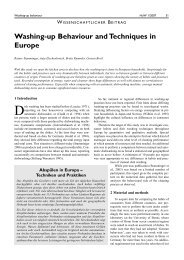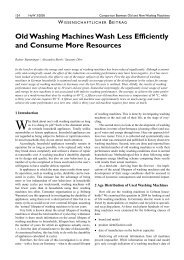Development of a novel mechatronic system for mechanical weed ...
Development of a novel mechatronic system for mechanical weed ...
Development of a novel mechatronic system for mechanical weed ...
You also want an ePaper? Increase the reach of your titles
YUMPU automatically turns print PDFs into web optimized ePapers that Google loves.
5.2 Virtual prototype <strong>of</strong> the rotary hoe <strong>for</strong> intra-row<br />
<strong>weed</strong>ing<br />
Results and discussion<br />
The design <strong>of</strong> uncommon <strong>system</strong>s such as the rotary hoeing tool entails a lot <strong>of</strong><br />
trials and contains many errors, which need to be fixed be<strong>for</strong>e the first real<br />
prototype can be built.<br />
The optimisation <strong>of</strong> the hoeing tool design was done with Pro/Mechanca, which<br />
allows simulation <strong>of</strong> the trajectories, accelerations, velocities and <strong>for</strong>ces acting<br />
with the prototype. A variety <strong>of</strong> objects can be assembled together to resemble<br />
more closely the real conditions, including springs, motors, friction, and gravity.<br />
All the input variables such as speed and initial position can be altered at any<br />
time, providing testing and analysis flexibility. Constraints can also be placed on<br />
the prototype’s range <strong>of</strong> motion to more closely emulate a physical prototype.<br />
During a simulation, the motion behaviour <strong>of</strong> the parts <strong>of</strong> the prototype can be<br />
activated at different positions in the time domain, because their movement<br />
corresponds to a particular motion controller known as motor. Motors can be<br />
independently programmed to start and end at any point in the simulation, so if<br />
only certain parts <strong>of</strong> the assembly are <strong>of</strong> interest <strong>for</strong> a certain simulation, all the<br />
other parts can be simply turned <strong>of</strong>f and left idle.<br />
Taking into account demands and constrains, a virtual prototype <strong>of</strong> the rotary<br />
hoeing tool <strong>for</strong> intra-row <strong>weed</strong> control was designed. Several concepts were<br />
brainstormed and the idea <strong>of</strong> the <strong>system</strong> emulating the manual hoeing motions<br />
under the soil surface was chosen. The hoeing tool consists <strong>of</strong> an arm carrier<br />
and three or more integrated arms rotating around a horizontal axis above the<br />
crop row. The axis is attached to the motor shaft whose rotational speed is<br />
calculated and tuned according to the <strong>for</strong>ward speed <strong>of</strong> the carrier vehicle, the<br />
intra-row distance between plants and the observed position <strong>of</strong> the arms. The<br />
working height <strong>of</strong> the whole assembly is adjustable in accordance to keep the<br />
hoeing depth within optimal limits, which should be between 10 mm and 30 mm.<br />
The concept <strong>of</strong> the rotary hoeing tool <strong>for</strong> intra-row <strong>weed</strong>ing is presented in<br />
Figure 5.5.<br />
71





